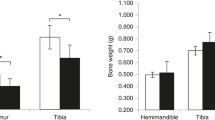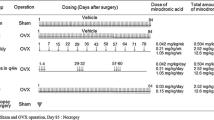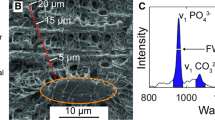Summary
Alendronate (4-amino-1-bydroxybutylidene bisphosphonate) is a novel amino bisphosphonate that is being developed for the treatment of osteolytic bone disorders such as osteoporosis. As part of a 2-year carcinogenicity study, we investigated the morphologic and biomechanical effects of long-term alendronate (ALN) therapy, given throughout skeletal growth, maturation, and aging, on rat vertebrae and femora. Three treatment groups, receiving either deionized water, low- (1.00 mg/kg), or high-dose (3.75 mg/kg) ALN, were given daily oral treatment for 105 weeks. Results from mechanical tests indicate that ALN therapy (in males) increased the vertebral ultimate compressive load by 96% in the high- and 51% in the low-dose groups when compared with controls. ALN similarly increased the male ultimate femoral bending load by 59% in the high- and 31% in the low-dose groups. Vertebrae and femora from female rats treated with both high- and low-dose ALN also failed at significantly higher loads than controls, but no differences were seen between low- and high-dose groups. Morphologic analysis of both male and female vertebrae revealed a dose-dependent increase in area fraction of bone. Rats receiving high-dose ALN had a greater area fraction of bone than those receiving low doses. Both groups were greater than controls. Thus, the administration of ALN resulted in increased femoral cortical bending load when compared with control animals, as well as increased vertebral ultimate compressive load commensurate with a dose-related preservation of vertebral bone. We therefore conclude that long-term ALN treatment preserves the structural and morphologic properties of both cortical and trabecular bone in rats and, with further study, may provide a valuable alternative to current therapy for the treatment of osteoporosis.
Similar content being viewed by others
References
Anonymous (1984) Consensus conference: osteoporosis. JAMA 252:799–802
Smith D, Nance W, Kang K, Christian J, Johnston C (1973) Genetic factors in determining bone mass. J Clin Invest 52:2800–2808
Evans R, Marel G, Lancaster E, Kos S, Evans M, Wong S (1988) Bone mass is low in relatives of osteoporotic patients. Ann Intern Med 109:870–873
Riggs BL, Melton LJ (1983) Evidence for two distinct syndromes of involutional osteoporosis. Am J Med 75:899–901
Fleisch H, Bisaz S (1962) Isolation from urine of pyrophosphate, a calcification inhibitor. Am J Physiol 203:671–675
Fleisch H, Russel RGG, Francis MD (1969) Diphosphonates inhibit hydroxyapatite dissolution in vitro and bone resorption in tissue culture and in vivo. Science 165:1262–1264
Fleisch H (1987) Bisphosphonates-history and experimental basis. Bone 8:S23-S28
Schenk R, Eggli P, Fleisch H, Rosini S (1986) Quantitative morphometric evaluation of the inhibitory activity of new aminobisphosphonates on bone resorption in the rat. Calcif Tissue Int 38:342–349
Shinoda H, Adamek G, Felix R, Fleisch H, Schenk R, Hagan P (1983) Structural activity relationships of various bisphosphonates. Calcif Tissue Int 35:87–99
Reitsma PH, Bijvoet OLM, Verlinden-Ooms H, van der WeePals LJ (1980) Kinetic studies of bone mineral metabolism during treatment with (3-amino- 1-hydroxypropylidene)-1-1-bisphosphonate (APD) in rats. Calcif Tissue Int 32:145–157
deVernejoul MC, Pointillart A, Bergot C, Bielakoff J, Morieux C, Laval-Jeamet AM, Miravet L (1987) Different schedules of administration of 3 amino-hydroxypropylidene)-l, 1 bisphosphonate induce different changes in pig bone remodeling. Calcif Tissue Int 40:160–165
Flora L, Hassing GS, Cloyd GG, Bevan JA, Parfitt AM, Villanueva AR (1981) The long-term effects of EHDP in dogs. Metab Bone Dis Rel Res 4 & 5:289–300
Schenk R, Merz WA, Meuhlbaur R, Russell R, Fleisch H (1973) Effect of ethane- l-hydroxy-1,1-diphosphonate (EHDP) and dicloromethylene diphosphonate (CL2MDP) on the calcification and resorption of bone in the tibial epiphysis and metaphysis in rats. Calcif Tissue Res 11:196–214
Frost HM, Jee WSS (1992) On the rat model of human osteopenia and osteoporosis. Bone Miner 18:227–236
Sietsema WK, Ebetino FH, Salvagno AM, Bevan JA (1989) Antiresorptive dose response relationships across three generations of bisphosphonates. Drugs Exp Clin Res 15:389–396
Attardo-Parrinelo G, Merlini G, Pavesi F, Cremaa F, Fiorentini ML, Ascari E (1987) Effects of a new aminodiphosphonate (aminohydroxybutylidene diphosphonate) in patients with osetolytic lesions from metastases and myeloatosis: comparison with dicloromethylene diphosphonate. Arch Intern Med 147:1629–1633
Adami S, Salvagno G, Guarrera G, Montesanti F, Garavelli S, Rosini S, Cascio VL (1986) Treatment of Paget's disease of bone with intravenous 4-amino-1-hydroxybutylidene-1.1-bisphosphonate. Calcif Tissue Int 39:226–229
Thompson DD, Seedor GJ, Weinreb M, Rosini S, Rodan GA (1990) Aminohydroxybutane bisphosphonate inhibits bone loss due to immobilization in rats. J Bone Miner Res 5:279–286
Bickerstaff DR, O'Doherty DP, McCloskey EV, Hamdy NAT, Mian M, Kanis JA (1991) Effects of amino-butylidene diphosphonate in hypercalcemia due to malignancy. Bone 12:17–20
Toolan BC, Shea M, Myers ER, Borchers RE, Seedor JG, Quartuccio H, Rodan G, Hayes WC (1992) Effects of 4-amino1-hydroxybutylidene bisphosphonate on bone biomechanics in rats. J Bone Miner Res 7:1399–1406
Snyder BD, Hayes WC (1990) Multiaxial structure-property relations in trabecular bone. In: Mow VC, Ratcliff A, Woo SL (eds) Biomechanics of diarthrodial joints. Springer-Verlag, New York, pp 31–59
Wronski TJ, Dann LM, Horner SL (1989) Time course of vertebral osteopenia in ovariectomized rats. Bone 10:295–301
Li X, Jee WSS, Ke HZ, Mori S, Akamine T (1991) Age-related changes of cancellous and cortical bone histomorphometry in female Sprague-Dawley rats. Cells Materials (suppl) 1:25–35
Mazess RB (1982) On aging bone loss. Clin Orthop 165:239–252
Riggs BL, Melton LJ (1986) Involutional osteoporosis. N Engl J Med 314:1676–1686
Riggs BL, Warner HW, Dunn WL, Mazess RB, Offord KP, Melton LJ (1981) Differential changes in bone mineral density of the appendicular and axial skeleton with aging: relationship to spinal osteoporosis. J Clin Invest 67:328–335
Lotz JC, Gerhart TN, Hayes WC (1990) Mechanical properties of trabecular bone from the proximal femur: a quantitative CT study. J Comput Assist Tomogr 14:107–114
Keller TS, Mao Z, Spengler DM (1990) Young's modulus, bending strength, and tissue physical properties of human compact bone. J Orthop Res 8:592–603
Silbermann M, Schapira D, Leichter I, Steinberg R (1991) Moderate physical exercise throughout adulthood increases peak bone mass at middle age and maintains higher trabecular bone density in vertebrae of senescent female rats. Cell Materials 151–158
Burr DB, Martin RB (1989) Errors in bone remodeling: towards a unified theory of metabolic bone disease. Am J Anat 186:186–216
Frost HM (1988) Structural adaptations to mechanical usage: a “three way rule” for lamellar bone modeling. Comp Vet Orthop Trauma 1(2):7–17; 80–85
Miller SC, Jee WCC (1975) Ethane- 1-hydroxy-1-1-diphosphonate (EHDP) effects on growth and modeling of the rat tibia. Calcif Tissue Res 18:215–231
Miller SC, Jee WCC (1977) The comparative effects of dicloromethylene diphosphonate (CLMDP) and ethane- 1-hydroxy-11-diphosphonate (EHDP) on growth and modeling of the rat tibia. Calcif Tissue Res 23:207–214
Shellhart WC, Hardt AB, Moore RN, Erickson LC (1992) Effects of bisphosphonate treatment and mechanical loading on bone modeling in the rat tibia. Clin Orthop 278:253–259
Evans RA, Baylink DJ, Wergendal J (1979) The effects of two diphosphonates on bone metabolism in the rat. Metab Bone Dis 2:39–48
Mori S, Jee WSS, Li XJ, Chan S, Kimmel DB (1990) Effects of prostaglandin E2 on production of new cancellous bone in the axial skeleton of ovariectomized rats. Bone 11:103–113
Keller TS, Spengler DM, Carter DR (1986) Geometric, elastic, and structural properties of maturing rat femora. J Orthop Res 4:57–67
Kalu DN (1989) The aged rat model of ovarian hormone deficiency bone loss. Endocrinology 124:7–16
Reynolds JJ, Murphy H, Meulbauer RC, Morgan DB, Fleisch H (1973) Inhibition by diphosphonates of bone resorption in mice and comparison with grey-lethal osteopetrosis. Calcif Tissue Res 12:59–71
Miller SC, Jee WSS (1979) The effect of dicloromethylene diphosphonate, a pyrophosphate analog, on the structure in the growing rat. Anat Rec 193:439–462
Pead MJ, Skerry TM, Lanyon LE (1988) Direct transformation from quiescence to bone formation in the adult periosteum following a single brief period of bone loading. J Bone Miner Res 3:647–656
Frost HM (1986) Intermediary organization of the skeleton. CRC Press, Boca Raton
Sontag W (1986) Quantitative measurements of periosteal and cortical-endosteal bone formation and resorption in the midshaft of male rat femur. Bone 7:63–70
Sontag W (1986) Quantitative measurements of periosteal and cortical-endosteal bone formation and resorption in the midshaft of female rat femur. Bone 7:55–62
Ruff CB, Hayes WC (1982) Subperiosteal expansion and cortical remodeling of the human femur and tibia with aging. Science 217:945–948
Schapira D, Lotan-Miller R, Barzilai D, Silbermann M (1991) The rat as a model for studies of the aging skeleton. Cell Materials 181–188
Hansson LI, Menander-Sellman K, Stenstrom A, Thorngren KG (1972) Rate of normal longitudinal bone growth in the rat. Calcif Tissue Res 10:238–251
Frost HM (1987) Bone “mass” and the “mechanostat”: a proposal. Anat Rec 219:1–9
Author information
Authors and Affiliations
Rights and permissions
About this article
Cite this article
Guy, J.A., Shea, M., Peter, C.P. et al. Continuous alendronate treatment throughout growth, maturation, and aging in the rat results in increases in bone mass and mechanical properties. Calcif Tissue Int 53, 283–288 (1993). https://doi.org/10.1007/BF01320915
Received:
Revised:
Issue Date:
DOI: https://doi.org/10.1007/BF01320915




